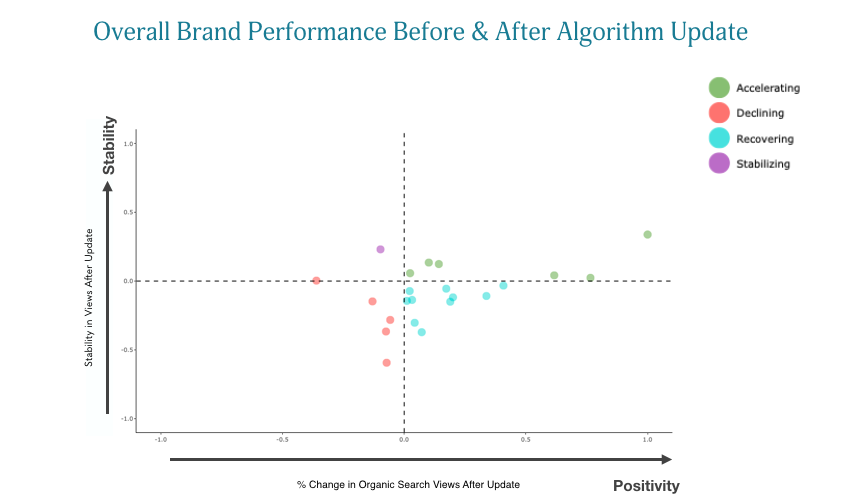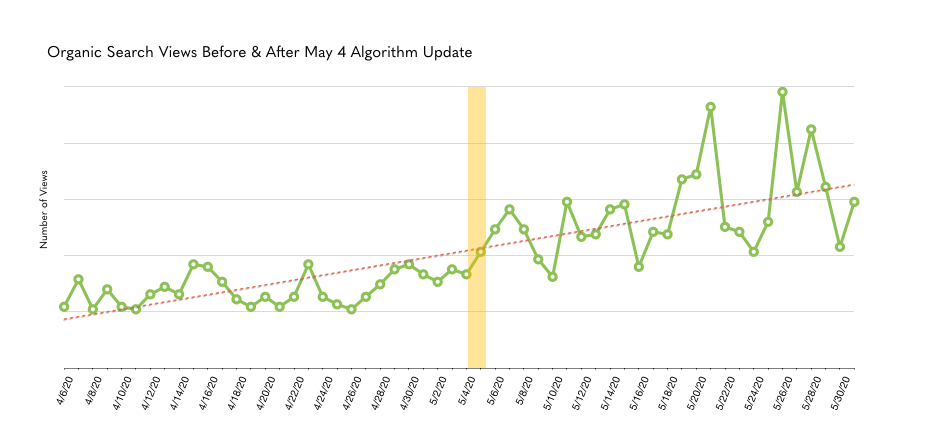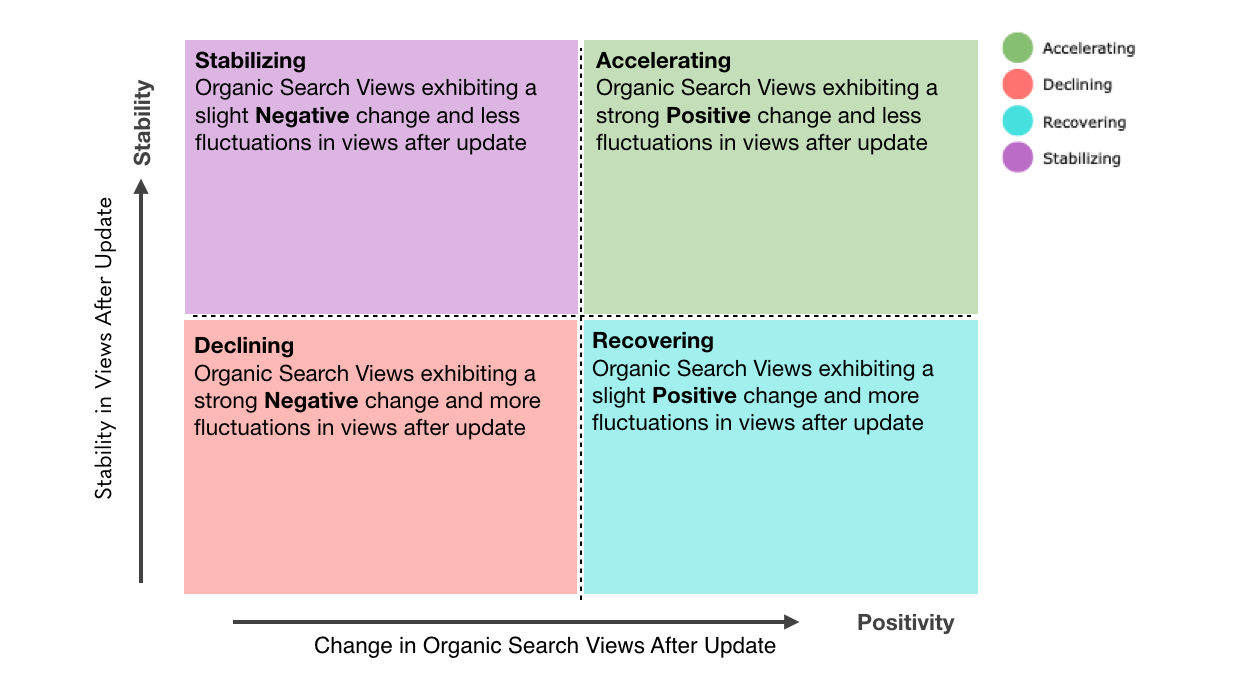Featured
How Has Google’s Search Algorithm Update Affected Your Traffic? Use the Impact Quadrant to Find Out
By Casey Nobile on June 24, 2020
If you detected a sudden change in your search traffic around May 4, you were likely impacted by Google's May 2020 core search algorithm update, its second major release this year. Just two days after its rollout, the update shook up search rankings to a 9.4 out of 10 on SEMrush's search results volatility sensor.
Similar to other broad core updates, this rollout took about two weeks as Google made its final tweaks. Now that we're six weeks in and the dust has settled, it's a good time for a midterm assessment of this algorithm change's impact on your site. Strong search performance after an algorithm update is a good sign that your SEO strategy is working, whereas a sudden loss of traffic generally signals that your search approach needs work.
Skyword uses a tool called the Impact Quadrant to visualize the extent to which its clients' sites are impacted by widespread search events, such as algorithm changes. Using this tool, you can easily gauge both the strength and stability of your site's performance, as well as pinpoint where further investigation is needed. We're outlining how the Impact Quadrant works and sharing a downloadable spreadsheet, which you can use to plot your own site on the quadrant.
What Is the Impact Quadrant?
To triangulate the effect of an update, the Impact Quadrant measures two important aspects of search traffic data after algorithm changes:
-
Positivity: The strength of the resulting traffic increase or decrease after the algorithm update (x-axis).
-
Stability: The steadiness of the traffic changes via daily variations in traffic after the algorithm update (y-axis).
Using the spreadsheet provided above, you can plot each of your sites in one of four quadrants: accelerating, recovering, stabilizing, or declining. To put this in context, this is where 22 brand blogs across nine different industries landed four weeks after the initial May core update announcement:

Some sites are reconciling dramatic drops in traffic due to changes in their search visibility, whereas others are seeing their investments in quality and optimization pay serious dividends. Most sites, however, fell somewhere in between. As usual, Google hasn't revealed what specific changes were made as part of the May algorithm update, which has left some SEO experts theorizing about what factors may be driving these ranking changes.
It can be understandably frustrating whenever Google switches things up, sure, but algorithm changes are a necessity. By understanding how Google's algorithm updates work, you can take proactive steps to maintain—or even boost—your traffic and provide better user experiences.
How Do Google Algorithm Changes Affect Search Traffic?
Every change that Google makes to its search engine algorithm is designed with one purpose in mind: to improve its ability to deliver the best results for each search. Updates are necessary to keep current with audience and market trends (for example, the explosive rise of mobile search) and to apply new technologies and innovations to the search process (for example, advances in natural language processing).
In general, Google is always changing how it:
- understands user search intent
- evaluates content to determine its search relevancy
- ranks content that satisfies search criteria
- presents content on its SERPs
All or a combination of these factors can come into play with any single algorithm update.
Google frequently makes small changes to its algorithm, but it publicly announces a broad core update every few months. These larger and more impactful algorithm changes are also designed to improve the relevance of search results, however, they can affect a large number of sites in a significant way. Occasionally, Google will preannounce an algorithm change to give site owners an opportunity to adjust to meet the new standards, such as when it gave a six-month notice ahead of launching its forthcoming page experience update.
When Google makes a change to its algorithm, the content on its SERPs may get reshuffled or change dramatically as a consequence. Content that disappears or appears lower on SERPs after an update has presumably been deemed less relevant to the search, less credible, less informative, or less convenient to engage with. Losing visibility on SERPs will, naturally, have a negative impact on search traffic. Conversely, sites will see an increase in their organic search traffic if their content is deemed higher quality and, thus, moved to a higher position on key SERPs or begins to appear in a larger number of SERPs.
In other words, search traffic is the ultimate indicator of an algorithm's outcomes and ranking changes are the key determinant. A quick assessment of traffic four weeks before and after the update will tell you if the outcomes for your site are initially positive or negative. A positive outcome may look something like this:

The Impact Quadrant takes this a step further, helping you articulate the story behind your shifting traffic patterns. What's more, it gives you a standard way to compare performance across your sites and helps you justify a proportional response based on your results.
Keep in mind, the x-axis value is your positivity, or the change percentage in views from before and after the algorithm update. The y-axis value is your traffic stability, which is determined by the degree of fluctuation in your performance before and after the algorithm change.

How to Use the Impact Quadrant
To begin using the Impact Quadrant, download this spreadsheet and follow the steps on the instructions sheet to:
-
paste your organic data by day into the data sheet
-
find where your site is located in one of the four quadrants on the data sheet
-
paste data for other sites into additional rows to compare performance across several sites
Once you plot your site on the quadrant, use the following guide to inform your assessment and next steps:
-
Upper right = accelerating. This means your organic search traffic is improving in a stable way. In other words, the strength of your organic search traffic is increasing and you're seeing less fluctuation in traffic after the update. Although these results are encouraging, you shouldn't view them as an opportunity to rest on your laurels. Continue publishing quality content in line with SEO best practices to see continued success in search.
-
Consider: Rethinking your paid strategy if you're now ranking organically on keywords that you previously paid to rank on.
-
-
Lower right = recovering. This means your organic search traffic is improving but in a less stable way. Because of greater traffic fluctuation, your traffic could be experiencing only a slightly positive or neutral trend overall. This presents an opportunity to discuss making systematic adjustments to improve your search performance consistently.
-
Consider: Performing a content audit of high- and low-performing pieces and keywords to ensure future content is complementary to both your audiences' search trends and market trends. Ensure you have a keyword pillar strategy in place so you can focus your efforts and ensure on-page optimization is reinforced through your publishing practices.
-
-
Upper left = stabilizing. This means your organic search traffic is declining and that the degree of the downward trend is relatively steady. Turn this moment into chapter one of a turnaround story by focusing first on recovery, and then on growing your search views.
-
Consider: Looking closely at declines in specific keyword positions, especially for content with normally high search views. Check your site's authority score and revisit the quality of your content and on-page experiences to identify areas in need of long-term improvement. If your content has no obvious quality issues, you may be able to spur a speedier recovery by increasing your publishing volume and cadence.
-
-
Lower left = declining. This means your organic search traffic is noticeably decreasing or fluctuating significantly between negative and positive growth. Prioritize stabilizing your traffic and run through factors that contribute to successful content. (Backlinko has a list of more than 200 factors, some confirmed and some speculative, that Google uses to evaluate content.) This way, you can determine if any of these factors are contributing to this traffic trend.
-
Consider: Determining if any changes in your publishing volume or in your industry could be exacerbating your sudden decline in traffic. Audit any declines in your overall search rankings and first-page keywords to identify which content to potentially refresh. Also, compare your existing content to pieces produced by the brands that have taken over your position. Check for failures or gaps in your off-page search optimization tactics, such as meta descriptions or mobile site speed, as well as on-page tactics, such as using related keywords in titles and headers.
-
How to Future-Proof Your Content
Stay on top of Google's latest search algorithm changes so you can proactively check for shifts in your traffic. After all, a positive upswing after an update is a great opportunity to broadcast the ROI of your search strategy.
The best place to start is frequently checking Google's Webmaster blog for algorithm update announcements. These are often followed by reports from third parties, such as Search Engine Land and MOZ, about each update's initial effects. Skyword also publishes a summary of findings and recommendations after every algorithm update, as well as an annual State of SEO report that synthesizes the changes that matter most to brand marketers.
While you can't outsmart Google, you can future-proof your content so it can withstand sudden traffic disruptions and recover quickly from negative algorithm effects. The most resilient content ecosystems are built on quality content that tackles relevant topics, is consistently published, and includes the presence of highly searched, industry-specific keywords. Investing in content that genuinely helps your audience and presenting it in a user-friendly way can help you avoid negative backlash from future Google algorithm updates.
For more stories like this, subscribe to the Content Standard newsletter.
Featured image attribution: Life Of Pix on Pexels.

